Evil Eye Symbol Meaning Bible: Biblical Significance!
In the Bible, the evil eye symbolizes envy and moral corruption. Old Scriptures verses like Proverbs 28:22 and Deuteronomy 15:9 caution against greed and selfishness, metaphorically described as the ‘evil eye.’ In the New Scriptures, Jesus addresses the spiritual implications of envy, highlighting the need for inner purity in passages such as Matthew 6:22-23 and Mark 7:22.
Theologically, the concept underscores the importance of ethical behavior and spiritual vigilance. The persistent theme of the evil eye throughout scripture illustrates the enduring moral lessons it imparts.
Discovering these layers adds depth to understanding its significance.

Key Takeaways
- The evil eye in the Bible represents envy and ill-will, as seen in Proverbs 28:22 and Deuteronomy 15:9.
- Jesus emphasizes the moral and spiritual consequences of envy and malicious intent in Matthew 6:22-23 and Mark 7:22.
- The evil eye is associated with negative spiritual and moral implications, promoting inner purity and ethical behavior.
- Biblical texts use the evil eye metaphorically to highlight the dangers of greed, selfishness, and grudging spirits.
Historical Context

The concept of the evil eye, with its roots deeply embedded in ancient civilizations, has been referenced in numerous historical texts including the Bible, the Quran, and classical antiquity literature.
This pervasive symbol of malevolence is often associated with envy and the potential harm that envious gazes can inflict upon individuals.
In classical antiquity, the evil eye was considered a potent force, with Greek and Roman texts documenting its destructive impact.
Similarly, scriptural references in the Quran underscore the protective measures taken against it, while various Near Eastern cultures integrated talismans to ward off its effects.
This historical context reveals a consistent belief across diverse cultures in the evil eye’s ability to bring misfortune, necessitating protective interventions rooted in spiritual and cultural practices.
Old Testament References
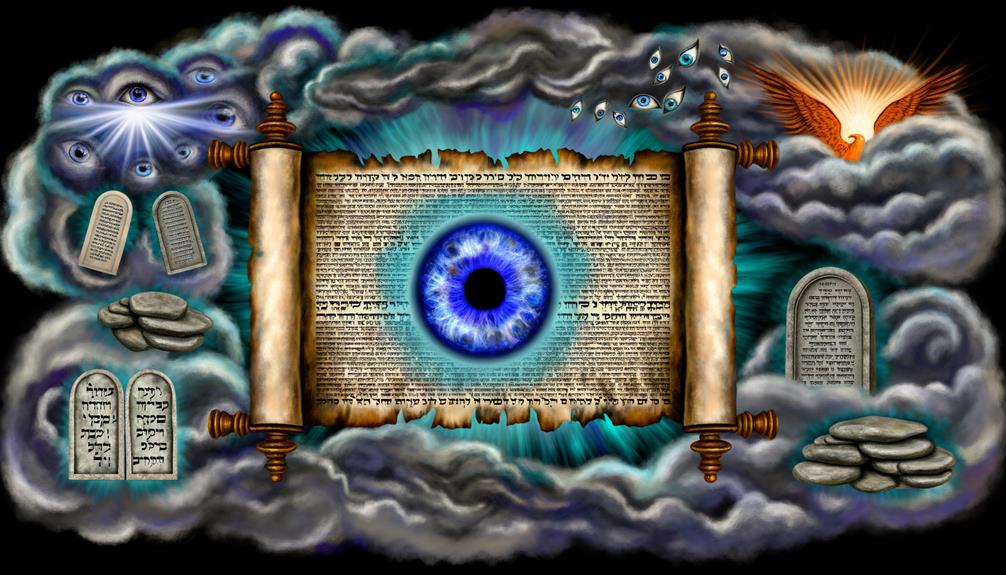
Numerous passages within the Old Scriptures allude to the concept of the evil eye, often portraying it as a manifestation of envy and ill-will. The Hebrew Bible references this notion, associating it with negative human emotions and actions.
For instance, Proverbs 28:22 warns, “A man with an evil eye hastens after wealth and does not know that want will come upon him,” illustrating the moral consequences of greed and envy.
| Scripture Reference | Interpretation |
|---|---|
| Proverbs 28:22 | Greed and its detrimental effects |
| Deuteronomy 15:9 | Warning against selfishness |
| Proverbs 23:6 | Caution against associating with the envious |
In Deuteronomy 15:9, the evil eye is a metaphor for selfish intentions, while Proverbs 23:6 advises against dining with a person possessing an evil eye, highlighting the broader social and moral implications.
New Testament Insights
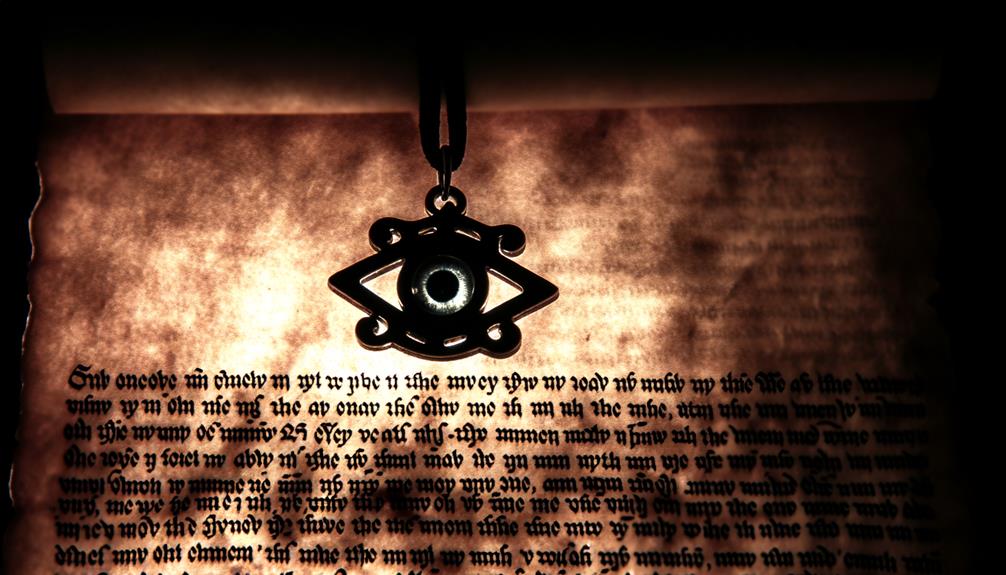
Within the New Covenant, the concept of the evil eye is explored primarily through the teachings of Jesus, who frequently addressed the moral and spiritual ramifications of envy and malicious intent.
Notable instances include:
- Matthew 6:22-23: Jesus speaks of the eye as the ‘lamp of the body,’ emphasizing the importance of a ‘healthy eye’ to avoid darkness.
- Mark 7:22: The term ‘evil eye’ is listed among the sinful behaviors that defile a person, underscoring its moral severity.
- Matthew 20:15: In the Parable of the Workers in the Vineyard, Jesus questions, ‘Is your eye evil because I am good?’ highlighting envy.
- Luke 11:34: Jesus reiterates the notion of the eye’s purity affecting one’s whole being, linking it to spiritual enlightenment.
These passages collectively elucidate the New Scripture’s perspective on the evil eye.
Symbolism and Interpretations

The symbolism of the evil eye encompasses a rich tapestry of interpretations rooted in ancient cultural beliefs, where it was often regarded as a powerful talisman against malevolent forces.
Scriptural references, such as Proverbs 23:6, ‘Do not eat the bread of a man who is stingy; do not desire his delicacies,’ illuminate the perceived dangers of envy and malevolence associated with the evil eye.
In modern religious perspectives, this symbol continues to hold a significant place, representing both spiritual protection and the pervasive influence of historical traditions.
Ancient Cultural Beliefs
Drawing from ancient cultural beliefs, the evil eye symbol has been interpreted as a protective talisman against malevolent forces across various civilizations. This symbol’s significance is reflected in several ancient cultures:
- Mesopotamia: Amulets with the evil eye were used to ward off envy and harm, often referenced in cuneiform texts.
- Ancient Egypt: The Eye of Horus served as a protective emblem, believed to provide health and safety, akin to the evil eye.
- Greek Antiquity: The evil eye, or ‘mati,’ was thought to cause harm through envious gazes, necessitating protective charms.
- Biblical References: Scriptures such as Proverbs 23:6 mention the ‘evil eye,’ illustrating its early acknowledgment as a symbol of negative intent.
These interpretations reveal the profound cultural significance of the evil eye across ancient societies.
Modern Religious Perspectives
In contemporary religious contexts, the evil eye symbol continues to embody significant spiritual and protective connotations, reflecting its enduring legacy through modern interpretations and practices.
Within Christianity, references to the ‘evil eye’ can be traced to passages such as Matthew 6:22-23, where Jesus speaks of the eye as the lamp of the body, implying the spiritual dangers of malevolent gazes. Modern theological interpretations often view the evil eye as emblematic of envy and spiritual warfare, advocating for vigilance and faith in divine protection.
Similarly, in Judaism, the concept of the ‘ayin hara‘ is addressed in texts like the Talmud, underscoring the need for prayer and righteous living to counteract negative influences.
Consequently, the symbol persists as a focal point in safeguarding spiritual integrity.
Cultural Influences
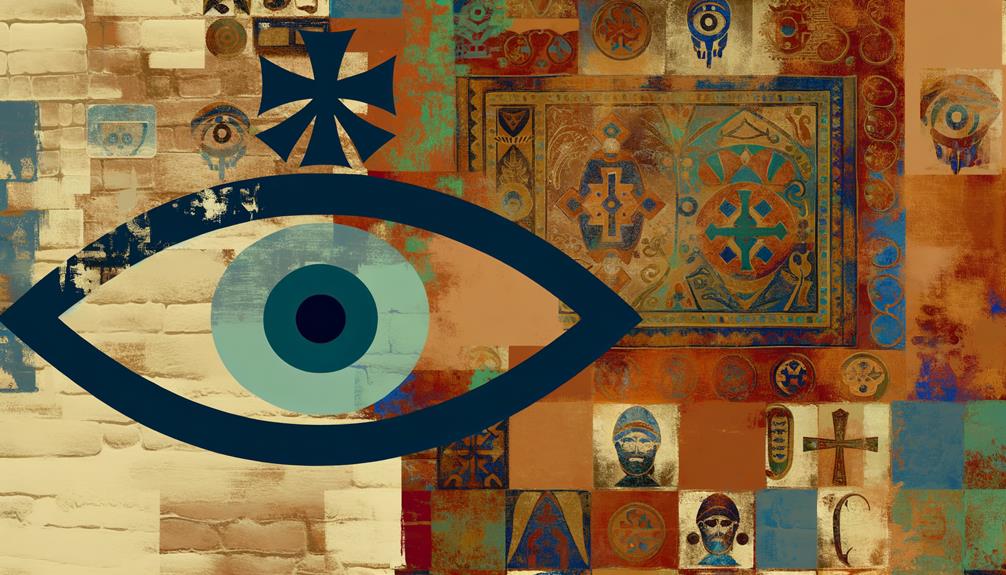
The historical symbolic significance of the Evil Eye spans various civilizations, from ancient Mesopotamia to contemporary societies, demonstrating its pervasive impact.
Cross-cultural interpretations, as seen in the biblical account of Proverbs 23:6 and the Quranic verse 113:5, underscore the diverse yet converging views on its protective qualities.
Contemporary adaptations further illustrate its relevance in modern societal contexts, blending traditional beliefs with new-age interpretations.
Historical Symbolic Significance
Tracing its origins back to ancient civilizations, the symbolic significance of the evil eye has been deeply influenced by various cultural beliefs and traditions. The concept is pervasive, appearing in numerous religious and historical contexts.
In the Bible, references can be observed in texts such as Proverbs 23:6 and Mark 7:22, where the ‘evil eye’ denotes jealousy and malicious intent.
To understand its historical roots, consider the following key points:
- Ancient Egypt: Amulets and carvings featuring the ‘Eye of Horus’ were believed to offer protection.
- Ancient Greece: Widespread belief in the evil eye’s power to inflict harm.
- Roman Empire: Usage of talismans to guard against envious glances.
- Jewish Tradition: Talmudic references highlight the evil eye’s potential to cause physical and spiritual damage.
These points underscore the historical depth and cultural layers embedded within the symbol of the evil eye.
Cross-Cultural Interpretations
Though its manifestations vary widely, the evil eye symbol consistently emerges across diverse cultures as a potent emblem of protection and a ward against malevolent forces.
In ancient Mesopotamia, it was believed that the evil eye could bring harm, a notion echoed in Islamic traditions where the Prophet Muhammad cautioned against envy (Hadith, Sahih Muslim 2188).
Similarly, Jewish texts reference the evil eye as a source of danger, advising against it (Pirkei Avot 2:11).
In Christianity, Matthew 6:22-23 speaks of the ‘eye’ as a lamp of the body, suggesting the moral implications of one’s gaze. The passage warns that if the eye is healthy and focused on the light, the entire body will be full of light. On the other hand, if the eye is “bad,” then the person is filled with darkness. This metaphorical use of the eye in Christian scripture is reinforced by the symbolic significance of sparrows in the Bible. According to Matthew 10:29, sparrows are used to illustrate God’s care and concern for even the smallest and seemingly insignificant creatures.
These cross-cultural interpretations underscore a shared human concern over the destructive power of envy and the universal desire for spiritual safeguarding.
Modern-Day Adaptations
In contemporary society, the evil eye symbol has evolved beyond its ancient roots to become a prevalent motif in fashion, jewelry, and popular culture, reflecting ongoing cultural influences and adaptations.
This evolution is marked by several key developments:
- Fashion and Accessories: The evil eye is frequently incorporated into clothing designs and accessories, symbolizing protection and warding off negative energy.
- Celebrity Endorsement: Numerous celebrities have popularized the symbol by wearing evil eye jewelry, thereby perpetuating its cultural significance.
- Globalization: The symbol’s spread across various cultures highlights its universal appeal and adaptability.
- Digital Media: Social platforms and digital art often feature the evil eye, blending traditional beliefs with modern aesthetics.
These adaptations illustrate the enduring relevance of the evil eye in contemporary contexts.
Theological Perspectives

Various theological perspectives offer distinct interpretations of the evil eye symbol, often rooted in scriptural texts and doctrinal beliefs.
In Christian theology, the concept of the evil eye is addressed in passages such as Matthew 6:22-23, where Jesus speaks of the eye as the ‘lamp of the body,’ emphasizing the moral and spiritual implications of one’s inner vision. Theologians often interpret this symbol as a metaphor for envy and malice, cautioning believers against harboring such negative emotions.
Additionally, in Deuteronomy 15:9, the evil eye is depicted as a sign of a grudging spirit, urging the faithful to practice generosity and kindness. These interpretations underscore the importance of inner purity and ethical behavior within the Christian doctrine.
Moral Lessons
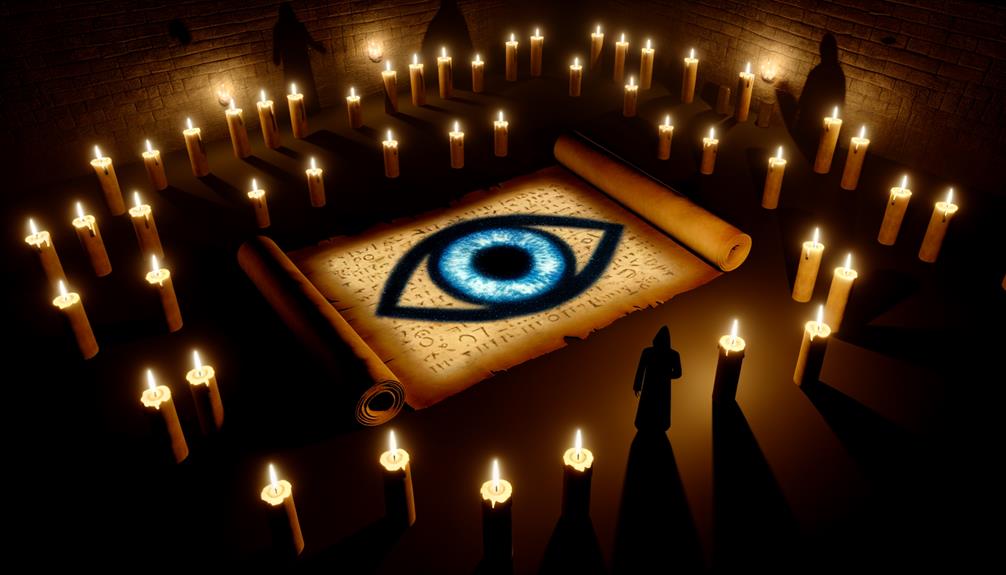
The moral lessons derived from the symbol of the evil eye often emphasize the significance of cultivating virtues such as humility, generosity, and vigilance against envy. These lessons draw from scriptural admonitions and provide a framework for ethical living:
- Humility: Proverbs 16:18 warns, ‘Pride goes before destruction,’ encouraging humility as a safeguard against the peril of the evil eye.
- Generosity: Acts 20:35, ‘It is more blessed to give than to receive,’ underscores the importance of generosity to counteract jealousy.
- Vigilance: 1 Peter 5:8 advises, ‘Be sober-minded; be watchful,’ highlighting the need for vigilance against envious thoughts.
- Contentment: Philippians 4:11-12 emphasizes learning to be content in all circumstances, reducing susceptibility to envy.
These principles foster a spiritually balanced life, promoting ethical conduct and inner peace.
Modern Relevance
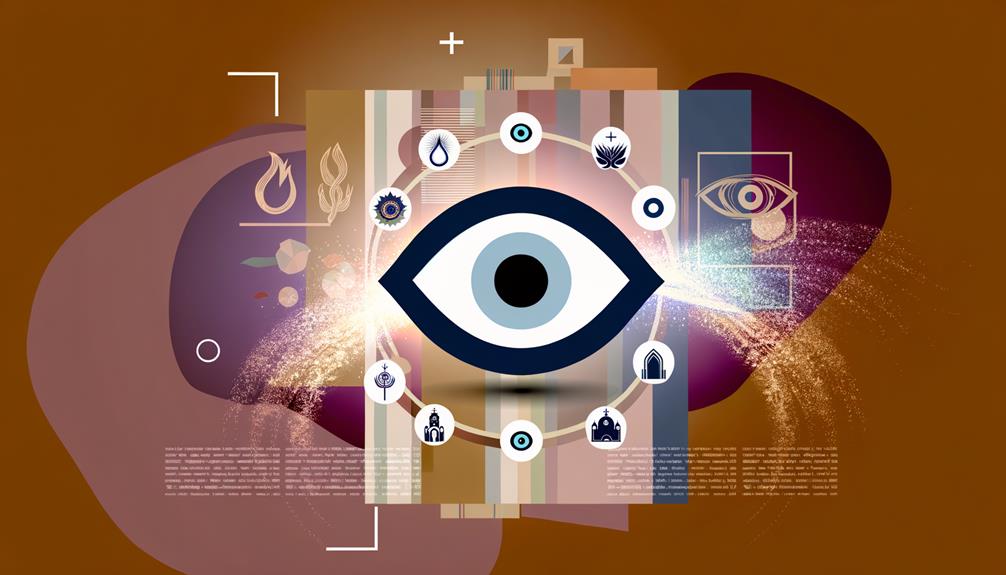
While the moral lessons rooted in ancient texts offer timeless wisdom, the symbol of the evil eye continues to hold significant modern relevance, manifesting in contemporary culture and daily life.
This ancient emblem, referenced implicitly in scriptures such as Matthew 6:23, has transcended its original context to become a widely recognized symbol of protection against malevolent forces.
Today, it is often employed in jewelry, home decor, and fashion, symbolizing a collective consciousness that seeks to ward off envy and negativity.
This enduring symbol reflects a universal human concern with the safeguarding of well-being, illustrating the persistent influence of ancient spiritual beliefs on modern practices.
Consequently, the evil eye remains a pertinent and potent element in contemporary cultural expressions.
Conclusion
The concept of the ‘evil eye,’ though not explicitly named in the Bible, carries significant weight in scriptural and cultural contexts.
A fascinating statistic reveals that 36% of Americans believe in the power of the evil eye, reflecting its persistent influence beyond ancient texts.
Analyzing both Old and New Scriptures references, it becomes evident that the symbol serves as a moral and theological caution against envy and malevolence, emphasizing the importance of virtue and divine protection.






